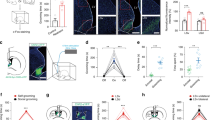Summary
Grooming induced in mice after a period of swimming was potently and dose-dependently blocked by neuroleptics. The order of potency of the neuroleptics was spiroperidol>haloperidol>cis-flupenthixol>pimozide>chlorpromazine>thioridazine. The trans isomer of flupenthixol was inactive at 40μM/kg. Theα-adrenergic receptor antagonists, phentolamine and phenoxybenzamine, and the catecholamine synthesis inhibitor,α-methyl-p-tyrosine were essentially without effect on the grooming behaviour. Amitriptyline inhibited grooming behaviour only in doses which severely affected the animals motor function. Fluoxetine was without effect. Cisflupenthixol was less active in inhibiting grooming in animals chronically treated with haloperidol than in control animals, indicating the presence of supersensitive dopamine receptors. The data indicate that swim-induced grooming in mice is mediated via dopaminergic systems.
Similar content being viewed by others
References
Andén, N.-E., Strömbom, U. Adrenergic receptor blocking agents: effects on central noradrenaline and dopamine receptors and on motor activity. Psychopharmacologia (Berl.)38, 91–103 (1974).
Burt, D. R., Creese, I., Snyder, S. H. Antischizophrenic drugs: chronic treatment elevates dopamine receptor binding in brain. Science196, 326–328 (1977).
Buus Lassen, J. Evidence for a noradrenergic mechanism in the grooming produced by (+)-amphetamine and 4,α-dimethyl-m-tyramine (H77/77) in rats. Psychopharmacol.54, 153–157 (1977).
Chesher, G. B., Chan, B., Whaite, C. Stress-induced analgesia in mice. In: Problems in Pain (Peck, C., Wallace, M., eds.), pp. 34–46. Sydney: Pergamon Press. 1980.
Chesher, G. B., Jackson, D. M. Post-swim grooming in mice inhibited by dopamine receptor antagonists and by cannabinoids. Pharmac. Biochem. Behav.13, 479–481 (1980).
Dunn, A. J., Green, E. J., Issacson, R. L. Intracerebral adrenocorticotropic hormone mediates novelty-induced grooming in the rat. Science203, 281–283 (1979).
Dunstan, R., Jackson, D. M. The demonstration of a change in adrenergic receptor sensitivity in the central nervous system of mice after withdrawal from long-term treatment with haloperidol. Psychopharmacol.48, 105–114 (1976).
Finney, D. J.: Probit Analysis. Cambridge University Press. 1971.
Gispen, W. H., Wiegant, V. M. Opiate antagonists suppress ACTH1-24-induced excessive grooming in the rat. Neuroscience Letters2, 159–164 (1976).
Gispen, W. H., Wiegant, V. M., Greven, H. M., de Wied, D. The induction of excessive grooming in the rat by intraventricular application of peptides derived from ACTH: structure-activity studies. Life Sciences17, 645–652 (1975).
Katz, R. J. Central injection of substance P elicits grooming behaviour and motor inhibition in mice. Neuroscience Letters12, 133–136 (1979).
Katz, R. J., Roth, K. A. Stress-induced grooming in the rat—an endorphinmediated syndrome. Neuroscience Letters13, 209–212 (1979).
Wiegant, V. M., Cools, A. R., Gispen, W. H. ACTH-induced excessive grooming involves brain dopamine. Eur. J. Pharmacol.41, 343–345 (1977).
Wong, D. T., Horng, J. S., Bymaster, F. P., Hauser, K. L., Molloy, B. B. A selective inhibitor of serotonin uptake: Lilly 1104140, 3-(p-trifluoromethylphenoxy)-N-methyl-3-phenylpropylamine. Life Sciences15, 471 to 479 (1974).
Author information
Authors and Affiliations
Rights and permissions
About this article
Cite this article
Chesher, G.B., Jackson, D.M. Swim-induced grooming in mice is mediated by a dopaminergic substrate. J. Neural Transmission 50, 47–55 (1981). https://doi.org/10.1007/BF01254913
Received:
Issue Date:
DOI: https://doi.org/10.1007/BF01254913




